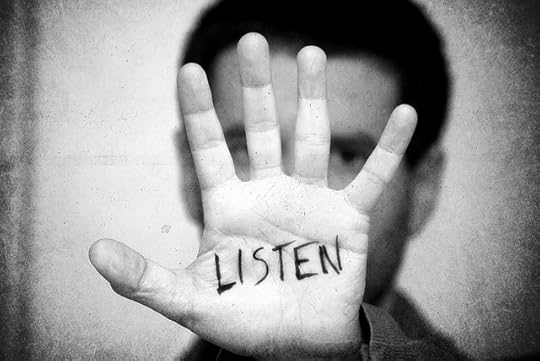Marcia Conner's Blog, page 3
November 5, 2013
Business Rules, Simplified
When people ask me about the most healthful workplace I’ve worked in, I get a bit nostalgic for the years I spent at PeopleSoft.
“What made it so special?” people ask. Recently I had the chance to talk with the co-founder of the company, Dave Duffield, who now is co-CEO at Workday, and told him what I share with others when they ask.
“It was Dave’s rules–or lack there of them–that set the tone and conveyed to everyone the company was out of the ordinary. Quirky, candid, and with the right priorities in mind,” I say. Dave sent them out quarterly through email entitled, “Dave’s Rules of Business Behavior.”
A decade later, I dug up the rules to share them with you here. Perhaps you’ll modify them to establish a wonderful environment for great work to thrive. Although the specific names may not mean anything to readers unfamiliar with the leadership at PeopleSoft, I suspect you can glean enough from the simple, people-focused themes to get started now. Have fun.
My favorite rules are #1 and #4, by the way. Which are yours?
Dave’s Rules of Business Behavior
Business Rule #1. Keep the Restrooms Clean.
Yes, I’ve been associated with this Business Rule from the early days of
PeopleSoft, and it’s even more important now than it was then. I remember either listening to, or reading from one of Tom Peters’ famous books on Customer Service. He gave an example of a passenger getting onto a plane, sitting down, and finding his fold-down tray covered with some mung from the previous flight. The passenger’s thought: “Wow. If they can’t handle the easy things like keeping the aircraft clean, how can they possibly deal with the hard things like engine maintenance?”
The customer/prospect analogy at PeopleSoft: “Wow, if they can’t keep the
restrooms clean, how can they possibly develop quality products?”
So, … please pay attention to the little things like keeping the restrooms, kitchens, hallways, and other public places — even your personal work area Ron, Rick, and Aneel — as clean as possible. Our prospects and customers will think more kindly toward our products and services.
Business Rule #2. When Away, Use DND.
DND = Do Not Disturb
Most everyone — including Peggy Taylor — is guilty of not using DND, and most everyone has been frustrated when trying to phone a fellow employee and have the phone ring 5 times only to find the person is away from his/her desk. This is equally frustrating to customers and prospects trying to reach us. They probably even think, “If they don’t have the courtesy of placing their phones on DND, I can’t imagine what their restrooms look like.”
So, … when you’re away from your desk for more than 10 seconds, place your phone on DND. In this manner, any person trying to reach you will immediately receive your voice message, and will not have to wait for the 5 rings to finish. Equally important, your adjacent co-workers can remain productive rather than being steamed at you for leaving your phone on YDD (Yes, Do Disturb). And keep in mind for your own self-interests, there are a bunch of crazies out there who would think nothing of blowing away their own family members for lesser crimes than leaving a phone on YDD.
Business Rule #3. Keep Up With Your Voicemail.
How many of us enjoy the all-too-familiar “Phonemail System Voice Storage is full. Please delete those messages which are not needed”. And there’s no way to bypass this sucker. So we’re all being punished because a few of us have to save every flippin’ message Mark Jacobs has sent us.
A career side-benefit: If you keep up with your voicemail, people will actually think you’re doing work, even though you’re probably out on the golf course.
Business Rule #4. Don’t Kiss Up and Slap Down.
This is mostly a rule for people who have other people working for them (or, at least think they do). We’ve had — I emphasize HAD — a couple of people at PeopleSoft who thought proper business behavior was to play business kissy-face with one’s boss, and possibly the boss’s boss, all the while playing slappy-face with the people they manage. In other words, they play Jacqueline Kennedy Onasis with their superiors and Atilla the Hun with those they manage.
It’s a good career idea at PeopleSoft to behave consistently regardless of who you’re dealing with. Treat fellow employees, customers, prospects, suppliers, Betty Landes at Ackerman, and the bagel delivery people with the same respect and courtesy you’d offer the late Jerry Garcia.
Business Rule #5. Don’t Attach Big-Mother Files to your Notes.
How many of us have been out in some Caribbean island, one or more rum
concoctions in hand, attached to the local phone system (where the rates are published in bold, 24-point sans serif type), replicating your mail file, only to wait an eternity to get that one important message that Jeff Beinke has sent you — something about a Kim Carothers HR demonstration to a Florida-based men’s lingerie company for the vertically challenged. You might have to go through another rum thing or two before the replication is complete. Frustrating isn’t it?
Business Rule #6. Paging and Productivity are Antonyms.
How many times have you been involved with desk-checking a four-dimensional loop of actuarial calculations when from overhead you hear: “Anthony Damaschino, please dial *81, Anthony Damaschino, *81″. It’s back to the beginning of desk-checking for you.
Not only is this anti-productive for you, your co-workers, and our receptionist, but Anthony doesn’t like to have his name mentioned in public — something which dates back to our original bowling league with Jim Bozzini’s pink bowling ball.
So, … please only use the paging capabilities when absolutely necessary. In fact, I’ve asked several right-wing anti-paging enthusiasts to craft their own business rule for paging. Here goes:
“Excessive paging and unmonitored ringing telephones are disruptive to
co-workers. Realistically determining your availability and communicating this to your customers and co-workers will allow for fewer interruptions and greater accessibility to everyone.”
They’re so right-wing they even had to get a dig in regarding the telephones.
Business Rule #7. Be A Tightwad.
I’m a tightwad — I eliminated cookies from catered lunch menus, except those for customers and prospects. Even eliminated them from our quarterly Board of Directors’ meetings. I still pick up pennies off the street. Howard Gwin may not pick up pennies, but he does dimes or better. Peggy too — she clips coupons. But I’ve recently heard some really gut-wrenching examples of people unnecessarily wasting PeopleSoft money. Unbelievable stuff like people opting for more expensive flights or hotel rooms just so they can get extra miles or “points”. That makes a tightwad like me really P-Oed. You can bet that this is not the kind of Profitability our core values refer to. And as one employee said
to me recently in a note, “the little things, [like this] if abused, really suck for the entire company.”
Besides Anthony Damaschino’s salary, travel is our company’s biggest expense. You probably know how Al Castino and the Travel Squad are planning to get travel costs under control by requiring pre-approvals. (I’m not sure yet what we’re doing to get Anthony’s salary under control). In fact, there are plenty more ways we can all save the company money. Think twice about getting on a plane to attend a meeting — conference call or videoconference in. Schedule flights with layovers where much lower rates are available. Re-use office supplies. Don’t send all mail via Fed Ex. And PL-EEEEEASE, take advantage of pre-negotiated hotel rates. Treat PeopleSoft resources like they’re your own — and they are.
Frugality can have a big impact on our bottom line — and therefore our stock price and your current and future worth. Ask Peggy. It sure saves on her groceries.
Business Rule #8. Use PeopleSoft Systems and Equipment With Discretion.
No pussy footing around here: Do not use your computer, email, or other
PeopleSoft supplies or equipment for any activities that would make your mother question her decision to be a parent. PeopleSoft provides you with the best equipment available to help you do your job better, not to support wacked-out extracurricular activities. Flame mails and offensive Internet activities are not classy. Don’t send this stuff around. And don’t post it on PeoplePeopleTalk. It doesn’t fit in with our culture here, where we respect the gender, race, opinions, ear-lobe apparel, and choice of clothing of all employees. As you well know, PeopleSoft is a business, not a frat house. (Plus, this kind of stuff drives Larry Butler nuts — or more so than usual.)
So sure, you may need to send your accountant an email message. Or you may need to copy some important personal documents. That’s cool. We’d rather you use PeopleSoft equipment and systems rather than cut into your productivity by chasing all over town looking for a Kinko’s, especially since they’re not a customer yet.
No doubt this rule is subjective, but I’m sure you can figure out what’s
appropriate in our workplace and what’s not.
—-
Photo credit: Rule by Thomas Hawk







October 3, 2013
Could you make your job a dream job?
 Kris Dunn, on the HR Capali$t blog, wrote recently about Dream Jobs. What’s at the intersection of stuff you love to do, stuff you’re good at, and stuff someone will pay you to do? He had engaged in a conversation about, “What would your dream job be?” at a group function and it was now on his mind. It’s now on my mind, too.
Kris Dunn, on the HR Capali$t blog, wrote recently about Dream Jobs. What’s at the intersection of stuff you love to do, stuff you’re good at, and stuff someone will pay you to do? He had engaged in a conversation about, “What would your dream job be?” at a group function and it was now on his mind. It’s now on my mind, too.
He paraphrased that while the specific answers on dream jobs were all different, they all had the following in common:
“I wish I could do a job that had more purity in purpose, and had none of the political and red-tape BS I currently have to deal with.”
What leaped out at me most with this response is that most people will never achieve that dream without all of us making some big changes. We live in a world where business-as-usual means working through office politics and around hierarchy before even getting to do our jobs–let alone the rest of what we know needs to be done.
Many people have long-since abandoned any hope of not just raising their hands to help when something is wrong–but stepping up and leaning in to take action without permission free of fear from retribution.
It’s up to all of us, as the individuals who make up organizations, no matter our level in the pecking order, to create safe nests for others to fly in, then from.
In some cases that’s two lineworkers realizing they trust one another deeply enough to help each other out, even if that’s pushing company policy.
On a work team, that might be setting aside time each week to ask how to be more helpful to one another amid what’s narrowly defined as the job.
Division leaders could begin auditing the indirect costs of the people playing politics and the time required to hold up the façade of the hierarchy itself.
At the C-level, executives may look for feedback loops that up-regulate people working in honesty and good faith, and down-regulate practices that marginalize people doing what’s right.
Rather than look for new gigs, perhaps we should begin looking at the indirect costs to our employers and ourselves when we accept disconnection and playing win/lose games as the norm.
It’s time to use our talents and energy to systematically remove the obstacles in our paths and seeking out new healthier ways to play so our jobs can be interesting again and our dreams can become real.
Photo credit: We are only as strong as we are united by Juliana Coutinho







September 30, 2013
Stats on Workplace Learning

When I lead education at PeopleSoft a gazillion years ago, I shared with the head of all customer-facing services a copy of Training Magazine‘s annual numbers issue, published each November (now their November/December issue). His response wasn’t about the numbers rather, “There’s a magazine just about training?”
Recently I’ve been asked for various stats about workplace learning and the training industry in particular. With the popularity of my stats to make the case for social tools in business, post I realized others may also appreciate information on where to find data about learning at work. Although formal training accounts for only a small percentage of learning, unless noted specifically, the stats here relate to formal training, meaning that managed by a training department, usually through classes or online education (elearning) programs.
I welcome you adding additional sources of training stats in the comments below. I’ll add to this post over time, too.
From Training Magazine’s 2012 Training Industry Report (full download available for free):
Total 2012 U.S. training expenditures—including payroll and spending on external products and services—fell 6.5 percent to $55.8 billion.
After rebounding last year, the training industry hit a bump in the road in 2012 as it followed the downward economic trend that dogged the U.S.: Total 2012 U.S. training expenditures—including payroll and spending on external products and services—fell 6.5 percent to $55.8 billion, according to Training magazine’s 2012 Training Industry Report. Some 65 percent of organizations either saw their training budget remain the same or decrease in 2012. Training payroll increased substantially, from $31.3 billion to $36.4 billion, but spending on outside products and services decreased $1.7 billion to $7.4 billion.
The training budget figure was calculated by projecting the average training budget to a weighted universe of companies, using a Dun & Bradstreet database available through Hoovers of U.S. organizations with more than 100 employees. It is interesting to note that although small companies have the smallest annual budgets, there are so many of them that they account for 62 percent of the total budget for training expenditures.
From the ASTD 2012 State of the Industry (full report available to ASTD members, non-members for a fee):
More than $156 billion was spent by U.S. organizations on [formal] employee learning in 2012.
ASTD estimates that U.S. organizations spent $1,182 per learner on employee learning and development in 2011. Of this total direct learning expenditure, 56 percent ($87.5 billion) was spent internally — such as staff salaries and internal development costs. The remainder was split between tuition reimbursement, which accounted for 14 percent ($21.9 billion), and external services comprising 30 percent ($46.9 billion).
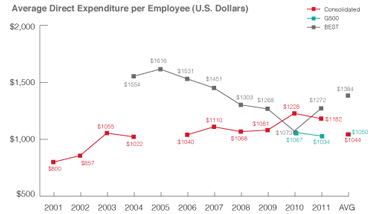
The average direct expenditure per employee decreased in 2011 to $1,182 from a peak expenditure of $1,228 ($1,267 adjusted for inflation) in 2010. This is a 4 percent (7 percent inflation adjusted) decrease on direct expenditure per employee on L&D activities and infrastructure.
Several factors influence the average spending per employee, including company size. Small companies typically spend more per employee on L&D than their larger counterparts. In 2011, small organizations with fewer than 500 employees spent on average $1,605, medium companies with 500 to 9,999 employees spent $1,102, and large organizations with a workforce size of more than 10,000 spent $825 per employee.
Fortune magazine’s Global 500 (G500) organizations that submitted data for the ASTD report on average spent $1,034 per employee on L&D activities and infrastructure in 2011, declining 3 percent from $1,067 in 2010. This group provides insight into spending for large multinational companies, which typically spend less per employee. Despite the slight drop in spending, employees continue to use the L&D opportunities their organizations offer.
On average, employees clocked 31 hours of training in 2011, which is about one hour less than 2010 and six fewer hours than a peak of 37 hours in 2007. However, it is five hours more than employees were using 10 years ago.
The number of learning hours an employee uses at each organization varies as widely as the organizations themselves. Employees at G500 organizations average slightly more than 35 hours of learning, which is almost five hours more than the consolidated average.
Organizations described by ASTD as BEST excel at weaving learning into the corporate culture. For the past seven years their employees have averaged more than 40 hours of learning, and this year employees at BEST organizations used on average 49 hours of learning.
Similar to past years, while the number of hours of learning an employee used remained stable, the cost per learning hour used has increased. The cost per hour of learning has increased by approximately $10 each year for the past four years.
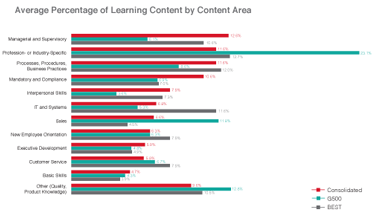 The top three L&D content areas for the consolidated group in 2011 were managerial and supervisory; profession- or industry-specific; and processes, procedures, and business practices. Together these three content areas account for 36 percent of the learning content available in the reporting organizations. This is not significantly different from last year when the same three categories topped the list and accounted for 34 percent of the learning content available. The bottom three content areas, accounting for 17 percent of the total, are executive development, customer service, and basic skills.
The top three L&D content areas for the consolidated group in 2011 were managerial and supervisory; profession- or industry-specific; and processes, procedures, and business practices. Together these three content areas account for 36 percent of the learning content available in the reporting organizations. This is not significantly different from last year when the same three categories topped the list and accounted for 34 percent of the learning content available. The bottom three content areas, accounting for 17 percent of the total, are executive development, customer service, and basic skills.
Organizations are increasingly implementing the use of technology, and methods such as mobile learning continue to gain in popularity. ASTD defines e-learning as “the use of electronic technologies to deliver information and facilitate the development of skills and knowledge.” After a slight dip in 2010, technology-based methods have rebounded to account for 37.3 percent of formal hours available across all learning methods.
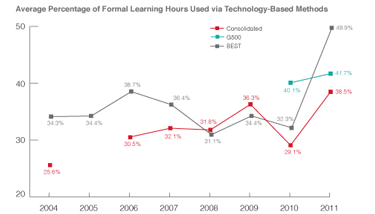 The consolidated group, BEST organizations, and G500 organizations all reported increased usage of formal learning hours used via technology-based methods. BEST organizations report a record high usage of technology-based learning with 50 percent of their formal learning hours being delivered via a technology-based method.
The consolidated group, BEST organizations, and G500 organizations all reported increased usage of formal learning hours used via technology-based methods. BEST organizations report a record high usage of technology-based learning with 50 percent of their formal learning hours being delivered via a technology-based method.
G500 organizations also have a strong and steady use of technology-based learning, delivering 42 percent of the formal learning hours via technology-based methods. Overall, the consolidated group reports a more moderate use of technology-based methods, accounting for 39 percent of respondents’ formal learning hours.
For the past several years, mobile learning has been a hot topic in the L&D industry. After a slow start, organizations are making progress in offering training via mobile devices. The consolidated group reported 1.4 percent of their training is available on a mobile device compared with 0.4 percent in 2010. With the increasing popularity of mobile devices, this benchmark will be one to closely monitor.
From Bersin by Deloitte’s The Corporate LearningFactbook® 2013: Benchmarks, Trends, and Analysis of the U.S. Training Market report (full report available to member organizations, available to non-members for a fee):
Mature companies spend 34 percent more. In 2012, U.S. companies spent an average of $706 per learner. However, organizations with mature, effective L&D functions (high-impact learning organizations) spent $867 per learner – 34 percent more than spending by companies at the lowest maturity level. High-impact learning organizations focus on improving performance through training and other talent initiatives. These L&D functions help to build the required human capabilities within their organizations to meet business goals and respond to change.
Large businesses triple their spending on social learning. Social learning is one catalyst for the transformation in L&D. In 2012, large U.S. companies spent just over $46,000 on average in 2012, nearly triple the spending of just two years ago. Social learning can be extremely effective when incorporated into a more structured program, such as combining a formal course with a learner discussion forum. In addition, high-impact organizations are becoming effective at creating employee networks, connecting novices to experts through expertise directories, and sharing knowledge through communities of practice. In this way, social learning, combined with formal programs, experiential learning and ongoing support and reinforcement, is facilitating a shift from blended training programs to continuous learning environments.
The L&D footprint continues to shrink. Although many training teams added staff during the year, these additions were outpaced by faster growth in learning populations. As a result, the overall “footprint,” or ratio of training staff relative to the learner population continued to decline in many companies. This trend is one sign of the changing role of the L&D function, which no longer is “the place” for learning. Instead, the role of the L&D team is to facilitate and enable learning. L&D teams should build skills in performance consulting, gain expertise in new technologies including social and mobile, and work to cultivate strong learning cultures within their organizations.
More spending on products and services. U.S. companies spent on average 16 percent of their training budgets on external learning services, up from 12 percent in 2009. The types of services purchased have changed, with more money going to off-the-shelf content and less to custom instructor-led training, as many companies turn to less costly and more time-efficient learning solutions. The research shows a different trend, however, among high-impact L&D organizations, which spend less on off-the-shelf content and more on instructor-led content development and delivery services. They also invest more in assessment services, which help them to develop skills where needed. Many training organizations start with standardized content, and then recognize the need for a more customized learning approach as they mature.
When asked recently what percent of training was for senior management learning and professional development, here’s how I answered:
“Training Magazine annual report (published last in their November/December 2012 issue) says about 10% of all money in training budgets is for training executives. Large corporations spend on average 11.3M total on training, mid-side orgs 2M, small $295K so theoretically 10% of each of those. Ballparking, that sounds about right to me, although I’ve seen some organizations allocate as much as 20% for senior leaders. Unlike many other parts of the organization that spends their own money on professional development, senior leaders do very little professional development on their own. Two exceptions are those who go get EMBAs (often reimbursed by the employer so that would be included in that 10%). The other exception is conference attendance, which is sometimes combined at a budget level into professional development within the training budget. That happens usually in organizations where funds allocated for T&D are passed down to the department level. In those that don’t, they scrounge for conference dollars wherever they can.”
photo credit: Thomas Hawk, I Can Gather All the News I Need on the Weather Report







August 4, 2013
Socially Awkward Networks
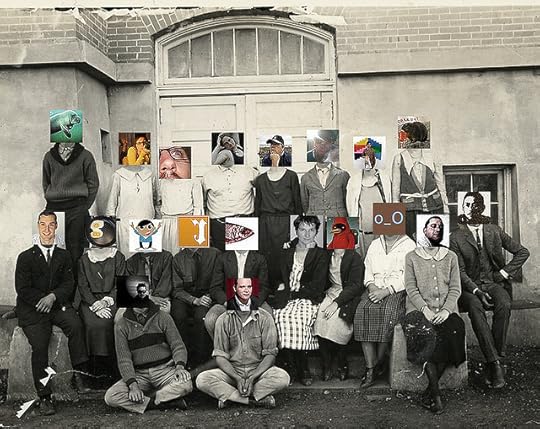
Last night I went to my high school’s 30th reunion. It was wonderful in ways I couldn’t have imagined and showed me that time (and perspective) can heal even wounds once made on tender hearts. 5 short years ago I wouldn’t have been ready to look back with such a giddy goofy grin. Proof came when I found a post I’d written for Fast Company in 2008, before our last reunion, which I didn’t attend. It’s about a classmate who wasn’t at this year’s reunion but who I might have felt differently about had she been there. Might. Here’s a reposting of that piece, not as a way to call out the awkwardness she offered. Rather, it shines light on the fact that growing up can be tough and social media has the potential to make it squirmable for years.
————–
A WOMAN, WHO AS A GIRL IN GRADESCHOOL TAUNTED ME ENTHUSIASTICALLY, contacted me through a social network site asking if I planned to attend an upcoming reunion.
At first I didn’t think much about it. I assumed she was on some committee for the gathering of once inelegant adolescents and she was contacting me as part of her new do-good campaign.
I replied in a perfunctory noncommittal way, and tucked her married name into my mental rolodex of people to avoid calls from if they appear on callerID.
She wrote again, reporting I looked healthy in my miniature photo and that I must be happy, how did I do it? Then she asked if we could connect directly on the site so we could correspond again.
When I mentioned to a colleague her reappearance in my life, he asked if I planned to tell her off. And what, I though, explain I’m not keen to chitchat with someone who went out of her way to torment me for a decade and whose young face flashed before my eyes when Mean Girls debuted?
Clearly she’s unaware I harbor less-than-friendly memories of her, and in hindsight I can see her inhospitability was probably not aimed at me alone. But BAM here she was.
This uncomfortable modern scenario raises an important question.
Should our social networks include only people we like, those we want to socialize with, and as my friend Jimm says, “Those we’d agree to take camping”? I don’t believe they were designed to be personal discomfort-free zones. Do you?
Although nobody chooses to spend precious time with overtly unlikable people, part of the power from loose and tight ties, is the depth and breadth of our networks: who we know who knows others and so on. The people just beyond our close ties’ collective intelligence represents our potential for connective intelligence.
If this former mean-girl (who has been nothing but sweet and cheerful in our recent communiqué) has a relationship with someone who can help me close an important deal for a client, it should not matter she invited my friends to a slumber party in fifth grade while stridently leaving me out. However, what about announcing to everyone in the junior high cafeteria I’d sneezed peas out my nose (which I hadn’t, it was mustard!)? That matters, yes?
All social situations offer us the opportunity to be uncomfortable in unexpected ways. We shouldn’t expect online social networks to be any different. It just seems easier to avoid the awkwardness when there’s no auto-reminder in seven days you haven’t yet engaged.
————–
p.s. No, the mustard (or peas) doesn’t matter anymore. I accepted her friend request after 5 years. I’m looking forward to healing that wound, too.
photo credit: Mallix, My Twitter Class of ’08
Originally published in Fast Company’s Learning Resource Center on April 7, 2008.







July 2, 2013
Working Hard Amid The Stars
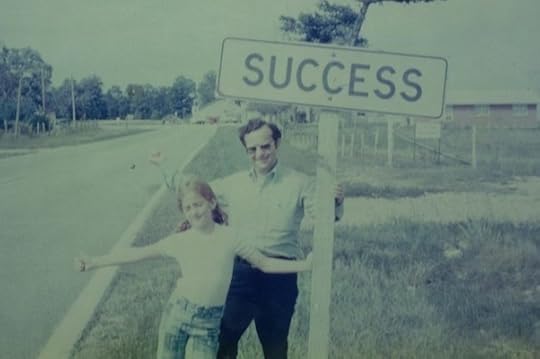
My dad, Bob, was the hardest working person I’ve ever known.
The son of immigrants, his dad died when my dad was very young. When his much older brother and sister left home, he grew up in the rooms behind a grocery store. His mom made his clothes, and he learned that the way to improve your situation was to work.
When I was born, my dad was a school teacher in Chicago’s inner city. He saw that work as a way to improve the situation of the bright, hopeful kids in that school.
Then his father-in-law, my grandfather Nathan, suggested he could assist in other ways too. When we moved to St. Louis he became a stock broker, working with so many of you — charting trends, identifying companies that were about to soar, seeing his work as the way to help people fulfill their dreams.
He never abounded his interest in working on helping–working on making a huge difference. When I was about my son Clarke’s age my dad told me why and how he did what he did, and that he knew someday I’d help change the world so all people could have hope.
Somewhere along the journey he began taking apart and assembling personal computers. As he worked on them, he told me and my brother Todd that technology would become a window into worlds (and work) we couldn’t even imagine back then. He also used his tinkering at the kitchen table to show that we should never be confined by the packaging of other people’s limited expectations. The day I met my amazing husband Karl, he was taking apart a computer. Perhaps it was then I knew he was the one.
My incredibly strong mom, Ann, recently described my dad as living “outside the box.” Yet as we talked about it more, we realized he really didn’t see there was a box. Anything was possible.
The week before last, I had the joyous opportunity to spend every day with my dad at his nursing home. Even though he was no longer able to say more than a few words at a time, he put on a big smile for everyone who entered his room. Each nurse and aide made a special point of telling me he went out of his way to show how much he appreciated them. Being kind and thankful had become his work–and he was working as hard as ever.
Many of us have heard the expression, “No one on their deathbed wishes they’d spent more time at work.” I think my dad may have been the exception.
He was working until the very end, and that’s just the way he liked it. In the nursing home, at the office, in our kitchen, in his garden growing giant squash, or on Creve Coeur lake in his sailboat… Even the sky wasn’t a limit. He used to tell me to reach for the stars because at the very least you’d reach the moon.
Here’s to my dad, with love. He’s right now, I have no doubt, working hard, amid the stars.







June 13, 2013
Turning Words Into Swords

Douglas Rushkoff’s critical editorial in the pages of GOOD Summer 2013 coaxed me out of my head and onto my keyboard. He wrote, “Reading a copy of GOOD provokes both inspiration and inferiority….While I like to think of myself as doing good, when I am confronted by a cadre of folks doing magazine-layout-worthy good, I am at once motivated and paralyzed.” I couldn’t have said it better myself. More pointedly, I didn’t.
For years I have described myself as a good but slow writer. The good part comes from decades of painstaking practice as a book writer and magazine editor–jobs that require my trademark vision and persistence. Their deadlines and expectations sharpen my attention. The slow part comes from years in anxiety-filled English classes where my lack of spelling skills lead to missing forrests for trees. [I now see I spelled forest wrong, but find it red-squiggly-underline ironic enough to leave in.] Although spellcheckers coach from the screen, uncomfortable memories sit on my desk. Reading succinct articles leave me inspired and envious. I run toward taking action elsewhere and rarely look back.
Rushkoff’s missive followed a passage from the magazine’s charter: [Implicit] is the pervading sense that we can always do a little better.
Rather than rip out the page to file away, I’m facing the screen and my demons–aiming to spur on others to not only read but to write. While the social-everything era makes it seem like more people have become bloggers than doers, I’m reminded right now that’s not so. If someone like me, who has written so much, feels insecure in her writing skills, many more people haven’t even considered capturing in words what they’ve done.
Our world needs inventive options from as many practitioners as possible, not just more sound-byte worthy ideas from pundits building brands. It’s time for me to surf this change. I invite you to join me in the waves.
If you have crafted a new and better way to work, I want to help you share your story. I’m a fellow traveler, deeply interested in illuminating what’s next. If I can work through self-doubts, my hunch is that you can too. Drop me a line. Unravel your saga. Let’s get clear on what’s holding us back.
With this post I’m gathering courage, sharing quickly (gasp!) what I’ve done right alongside notes on the journey. Perhaps I can provide a voice and a space that says, “Let’s try this together.”
I end here with Rushkoff’s close, both prescriptive to the magazine’s GOOD and our own. “My advice is to focus on groups over individuals, and verbs over nouns. It’s not the heroes who matter so much as the groups that have modeled their behavior; it’s not the things that matter so much as the actions we take.”
Here’s to turning our deeds into words and our words into swords.
———-
Note: Although I haven’t yet found an online version of Rushkoff’s piece, if I find one, I’ll post it here. If you find one, would you add it into the comments? It’s entitled, “Turning Swords Into Plows” on page 13 of the print edition.
Photo credit: BBMExplorer, Mother Russia, Mamayev Kurgan







June 11, 2013
Listen vs. Hear
The phrase “Customer Listening” or its partner-in-crime “Voice of the Customer” always elicits my twitch. Perhaps that’s because it sounds so dang phony, so “I serve people–perhaps I should learn their modern communication ways.” As if that should be followed by, “Surprise!” and accompanied by a photo of a fellow donning a Captain Underpants outfit over his worsted-wool suit. “I have supreme confidence I know it all!” might be what he said the day before.
I’m not against organizations engaging directly with people buying their wares. Nor am I insulted when companies distill from social media fresh insights on how people feel. If you’re doing one or both of those things, keep on doing that. Please. Consider doing more. Consider some of the amazing analytics tools from IBM and the like that let you find sea glass below your big data ocean. And we all know, with social media there’s plenty afloat. Hearing a brilliant whisper amid shouts has never been easier. Hurray! If you had supreme confidence yesterday, next week you’ll surely have more.
Yet despite customer listening campaigns and analytics capabilities, it’s seems to me that hearing still languishes. Listening is an activity. Hearing creates a change.
Never was this discrepancy more personal to me than when I learned of a new Kickstarter project. Imagining Learning interviews students across the U.S. on their experiences in school and how they might improve the place where they’ve been assigned to go learn. As you’ve possibly done a dozen or more times before, I went to the Kickstarter project page and I began watching (and listening) to some of the students who had been interviewed. Go do that. I’ll wait. Now welcome back.
Then I realized I hadn’t heard a word they had said. Did you? At first I noticed myself evaluating the quality of the campaign page. Why hadn’t they raised more yet? My social-media marketing instincts went into high gear. I asked myself, “Why wasn’t there a link to the actual interviews I’d heard described?” I want to help, but but but…
Only after a student in the video asked, “Can you come back next week?” did I catch a slapagram that broke my good-listener trance. Holy crap, I realized quickly. These aren’t people who it would be nice to listen to as part of some due diligence. These are people who go to school every day where they’re not listened to deeply. They’re in a place–in this case a school–where their voices are part of exercises and greater plans, not heard as opinions and perspectives that could possibly change everything. They aren’t some “other” group of people any more than customers are a company’s “others.” Students are why there are schools–not as recipients of goo to be poured into their heads. Not any differently than customers–the you-s and me-s of the world (who are students, too, by the way)–who are why companies exist at all.
When we focus on the listening, not the hearing, we can easily get caught up in the exercise and the greater plans. We can too easily forget that even if we knew everything, people want to be heard. And in our hearing them, in our resonating and acknowledging… in our internalizing and mixing their thoughts with ours… we can co-create something better than either of us could have done without the “other.”
In a business, learning of a technical issue with your website or your product ought to elicit questions to discover how to solve the problem (and prevent anyone else from having it). It ought to be one part of a healthy relationship between people who fundamentally need one another.
In a school, hearing a student–even if it requires bringing in an outside team to do the interviewing–ought to elicit questions to discover (and act on) how young minds imagine their world could be made better. Right here, right now.
If you haven’t already, check out the Imagine Learning project. They are working on creating a national collective voice. They (and I) believe students have invaluable things to say. How can we improve education? Really listen to young people.
Perhaps this project will remind you of something we can all hear again.
In a world with so much noise, sometimes the most insightful voices need to be both listened to and heard.
photo credit: Bryan Rosengrant, y2.d7 I that edit girl







May 13, 2013
Freestyle Learning
In 2009, Coca Cola set out to refresh the way soda was dispensed at restaurants such as McDonalds and Moe’s. It aimed to put choice in customers’ hands. It intended to empower its customer with the act of artistry.
Designed with the automaker Ferrari, Coca Cola introduced Freestyle; a sleek new approach to do more than serve soda. Freestyle is a drink machine that can mix over 100 different kinds of Coca Cola products including soda pop, power drinks, and flavored waters.
In a modern twist on the 1950s soda-shop float, Freestyle brings choice and collaboration to customers’ fingertips. Strangers and groups of diners alike, standing in front of this modern marvel, teach one another what they’ve created and introduce new possibilities in long-established mealtime patterns.
As thirsty consumers mix new flavors, Coca Cola, through built-in business intelligence, tests the new creations, deciding whether to bottle and market these drinks for others to enjoy.
Freestyle shows a glimpse into the future of customer expectations. It offers a vision—and even a model—for corporate learning.
Education represents a more complicated process than soda making, however it is also an inefficient business in need of creativity, choice, collaboration, and courage.
Today trainers serve a few dozen employees at once in expensive classrooms at frequently inconvenient times. Learning management systems disseminate and track courses that capture a small fraction of what’s learned across the enterprise. These characteristics pass as necessary until organizations reimagine and redefine success. Instead of educating a few hundred or thousand people a year, what if the learning function aimed to impact hundreds of thousands?
In a new paper out today entitled “Revolutionizing Corporate Learning” that I wrote with Dan Pontefract (author of the fabulous new book Flat Army) and Kerry Brown, we propose the concept of Learning Nouveau. It can offer both branded and personalized options that can be consumed in the precise manner that suits all the people served. Learning records can be tracked to provide and predict what people seek and how they wish to learn it. These options should reach far beyond that which was created by any one department and announces to the organization, “We provide a palette to learn most anything, anytime.”
Not only could learning managers become artists, they would lead organizations that are modern, well designed, simple, and fun.
[photo credit: April Bennett Photography]







April 28, 2013
Pop Music Good for Studies
Are you listening to music while you read this? The new app, Coffitivity, reminded me how much I prefer music to coffee shop chatter and airport terminal clatter (although I admit to having creative bursts with both in the background). That’s why I was delighted to find this short passage. What do you listen to when you study or work?
Studying to loud pop music may help children in school. At least that’s what British researchers found when they divided 11,000 children into three groups to listen to a pop radio station, classical music, and a discussion program.
On IQ tests, the kids listening to Top 40 music came out with scores 4 percent higher than the other groups’. “I think this is an emotional effect,” said researcher Susan Hallam of London’s Institute of Education. “The children enjoyed [the pop tunes] and were motivated.
(From the essential Hip Mama: writing from the cutting edge of parenting, ariel gore)
Much more from Sue Hallam on “The Power of Music.” (.pdf)







April 16, 2013
Develop a Culture for Tomorrow

I just re-read something Garry Ridge, CEO of the WD-40 Company, wrote for my book Creating a Learning Culture.
As a leader, I have always intuitively understood that it’s not my job to make people comfortable. And I don’t like being entirely comfortable myself, because that means I’m not moving forward.
Several years ago at a gathering of the International Mass Retailers Association, I met Don Soderquist, who was at that time vice chairman at Wal-Mart. My take-away from his presentation was this: “You have to separate those responsible for today from those responsible for tomorrow.” A light went off in my head as I realized the implications for WD-40. The company had gotten where it was with a team of people responsible for today. The company had done the same thing for more than 40 years–and its culture, management style, and leadership were deeply embedded in maintaining the status quo. If we wanted to develop a culture that could take us into tomorrow, we’d have to expand our tolerance for risk, devote more energy to learning, and actively court change.
How’s your tolerance for risk, your energy for learning, and your dedication to courting change? It seems to me 2013 may become the year organizations finally pay attention to improving their business culture. I’ve spoken with more seniors leaders over the past few months about fostering a healthy culture than in the last five years combined. Here’s to moving forward, together.
You can learn more about Garry from his terrific website, The Learning Moment (and its accompanying Facebook Page), in “A World of Magnificent Maniacs: Learning at WD-40,” an article we wrote together for a primer on culture a decade ago, and in a Forbes piece from 2011 about his leadership lessons.
[Image: CC image by Harvey K, buds coming]








